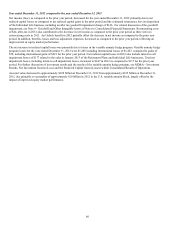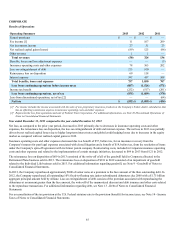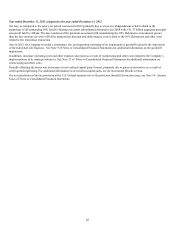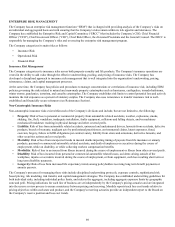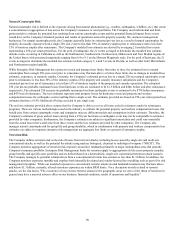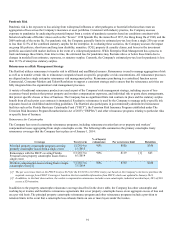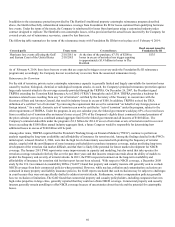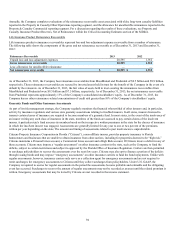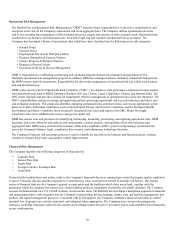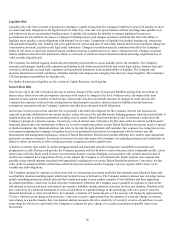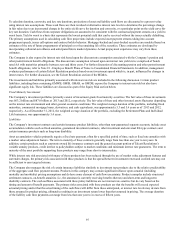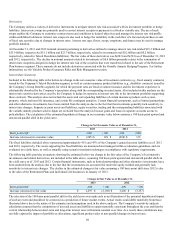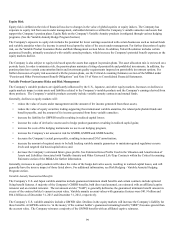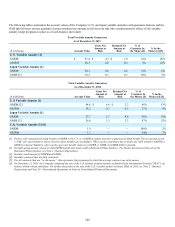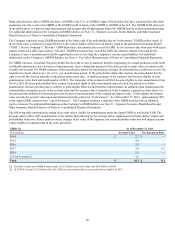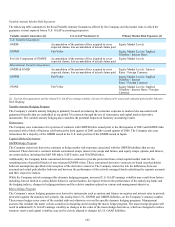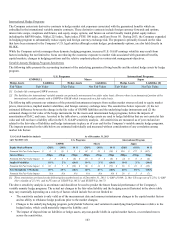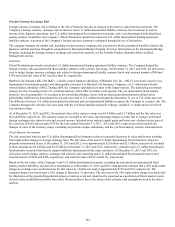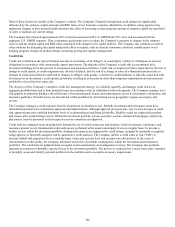The Hartford 2013 Annual Report Download - page 96
Download and view the complete annual report
Please find page 96 of the 2013 The Hartford annual report below. You can navigate through the pages in the report by either clicking on the pages listed below, or by using the keyword search tool below to find specific information within the annual report.96
Liquidity Risk
Liquidity risk is the risk to current or prospective earnings or capital arising from the company's inability or perceived inability to meet
its contractual cash obligations at the legal entity level when they come due over given horizons without incurring unacceptable costs
and without relying on uncommitted funding sources. Liquidity risk includes the inability to manage unplanned increases or
accelerations in cash outflows, decreases or changes in funding sources, and changes in market conditions that affect the ability to
liquidate assets quickly to meet obligations with minimal loss in value. Components of liquidity risk include funding risk, transaction
risk and market liquidity risk. Funding risk is the gap between sources and uses of cash under normal and stressed conditions taking into
consideration structural, regulatory and legal entity constraints. Changes in institution-specific conditions that affect the Company's
ability to sell assets or otherwise transact business without incurring a significant loss in value is transaction risk. Changes in general
market conditions that affect the institution's ability to sell assets or otherwise transact business without incurring a significant loss in
value is market liquidity risk.
The Company has defined ongoing monitoring and reporting requirements to assess liquidity across the enterprise. The Company
measures and manages liquidity risk exposures and funding needs within prescribed limits and across legal entities, business lines and
currencies, taking into account legal, regulatory and operational limitations to the transferability of liquidity. The Company also
monitors internal and external conditions, identifies material risk changes and emerging risks that may impact liquidity. The Company's
CFO has primary responsibility for liquidity risk.
For further discussion on liquidity see the section on Capital Resources and Liquidity.
Interest Rate Risk
Interest rate risk is the risk of financial loss due to adverse changes in the value of assets and liabilities arising from movements in
interest rates. Interest rate risk encompasses exposures with respect to changes in the level of interest rates, the shape of the term
structure of rates and the volatility of interest rates. Interest rate risk does not include exposure to changes in credit spreads. The
Company has exposure to interest rates arising from its fixed maturity securities, interest sensitive liabilities and discount rate
assumptions associated with the Company’s pension and other post retirement benefit obligations.
An increase in interest rates from current levels is generally a favorable development for the Company. Interest rate increases are
expected to provide additional net investment income, reduce the cost of the variable annuity hedging program, limit the potential risk of
margin erosion due to minimum guaranteed crediting rates in certain Talcott Resolution products and, if sustained, could reduce the
Company’s prospective pension expense. Conversely, a rise in interest rates will reduce the fair value of the investment portfolio and if
long-term interest rates rise dramatically within a six to twelve month time period, certain Talcott Resolution businesses may be exposed
to disintermediation risk. Disintermediation risk refers to the risk that policyholders will surrender their contracts in a rising interest rate
environment requiring the Company to liquidate assets in an unrealized loss position. In conjunction with the interest rate risk
measurement and management techniques, certain of Talcott Resolution's fixed income product offerings have market value adjustment
provisions at contract surrender. An increase in interest rates may also impact the Company’s tax planning strategies and in particular its
ability to utilize tax benefits to offset certain previously recognized realized capital losses.
A decline in interest rates results in certain mortgage-backed and municipal securities being more susceptible to paydowns and
prepayments or calls. During such periods, the Company generally will not be able to reinvest the proceeds at comparable yields. Lower
interest rates will also likely result in lower net investment income, increased hedging cost associated with variable annuities and, if
declines are sustained for a long period of time, it may subject the Company to reinvestment risk, higher pension costs expense and
possibly reduced profit margins associated with guaranteed crediting rates on certain Talcott Resolution products. Conversely, the fair
value of the investment portfolio will increase when interest rates decline and the Company’s interest expense will be lower on its
variable rate debt obligations.
The Company manages its exposure to interest rate risk by constructing investment portfolios that maintain asset allocation limits and
asset/liability duration matching targets which may include the use of derivatives. The Company analyzes interest rate risk using various
models including parametric models and cash flow simulation under various market scenarios of the liabilities and their supporting
investment portfolios, which may include derivative instruments. Measures the Company uses to quantify its exposure to interest rate
risk inherent in its invested assets and interest rate sensitive liabilities include duration, convexity and key rate duration. Duration is the
price sensitivity of a financial instrument or series of cash flows to a parallel change in the underlying yield curve used to value the
financial instrument or series of cash flows. For example, a duration of 5 means the price of the security will change by approximately
5% for a 100 basis point change in interest rates. Convexity is used to approximate how the duration of a security changes as interest
rates change in a parallel manner. Key rate duration analysis measures the price sensitivity of a security or series of cash flows to each
point along the yield curve and enables the Company to estimate the price change of a security assuming non-parallel interest rate
movements.


